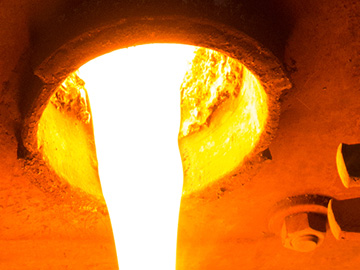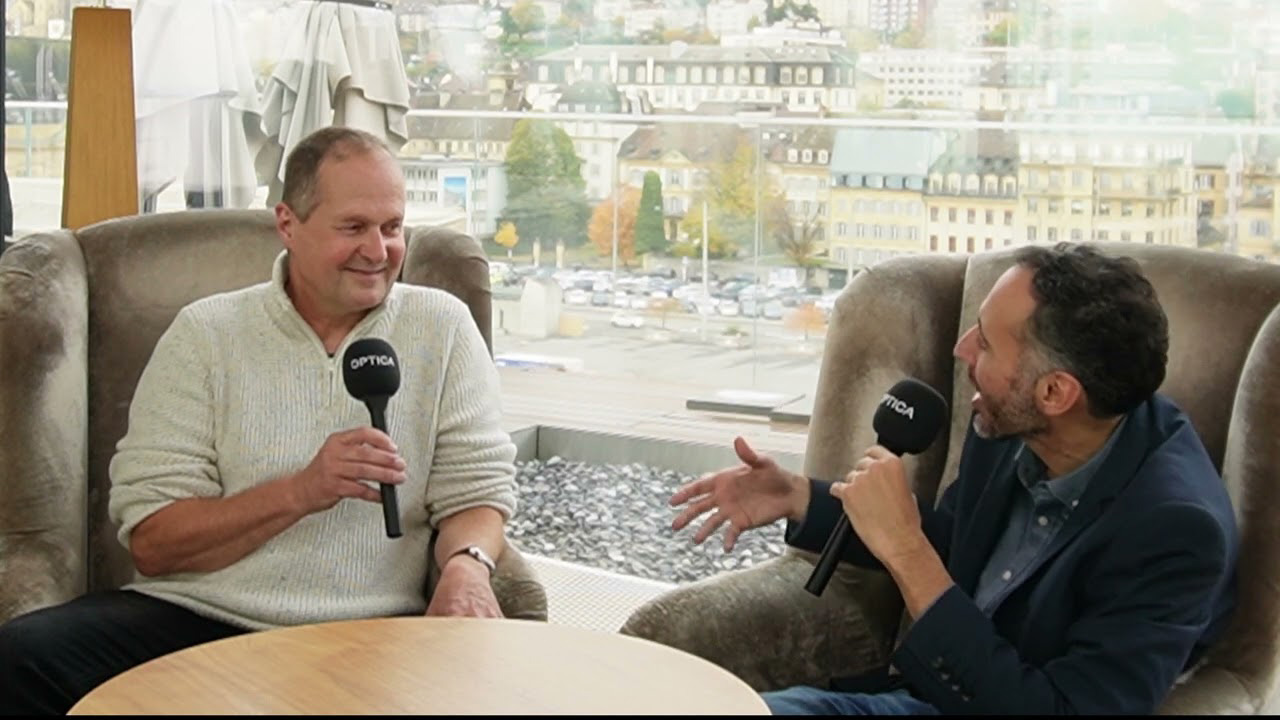An aerial view of Málaga, Spain. [Wikimedia Commons; CC-BY 1.0 ]
On 1 and 2 October in Málaga, Spain, a new Optica annual industry event will take flight—the Global Photonics Economic Forum. The Forum’s avowed aim is “to bring together up to 300 leaders from the global photonics industry, including corporate executives, political figures and investors, to engage in meaningful discussions that will shape the future of photonics.”
To learn more about the event, OPN recently spoke with one of its co-chairs, Reinhard Voelkel, who has worked in optics and photonics for more than two and a half decades. After obtaining his physics Ph.D. from FAU Erlangen-Nürnberg, Voelkel founded the company SUSS MicroOptics in 1999. He subsequently served as the firm’s CEO for nearly 25 years until its January 2024 acquisition by Focuslight Technologies. He now serves as Focuslight’s corporate chief strategy officer from the firm’s offices in Switzerland.
Why do you think there’s a need for something like the Global Photonics Economic Forum at this point in the industry’s history?
Reinhard Voelkel: You know, half of my life has had one foot in the semiconductor world. I even worked for a time with Bill W. Hugle, one of the founders of the big global semiconductor industry organization, SEMI. So I’ve seen these two different worlds—semi and photonics. They are really about the same size. But in semiconductors, you have a big organization, SEMI; you have SEMI.org; you have SEMI standards. You get government chips acts and a lot of attention. And today everyone knows what a microchip is, because if the right microchip isn’t available, your car key doesn’t work.
In the photonics world, “we don’t know who we are, and we don’t talk to each other. And we need to.”—Reinhard Voelkel
The photonics world is different. If you go online and have to fill out a form that asks “Which industry do you work in?” you never see photonics as an option. We don’t exist. And we don’t talk to each other.
And we also sometimes don’t even know who we are. There’s always this question, for example—is the solar industry photonics? Some people say, “No, no, no; we don’t want solar.” But what is solar doing? Solar takes a photon and generates electrons. OK—so what does a CMOS image sensor do? It takes a photon and generates electrons. Is that photonics? What about optical sensors?
So we don’t know who we are, and we don’t talk to each other. And we need to.
How did this idea for the new Forum—which I think you’re calling the “Davos of Photonics”—come about as a way to address that?
Jose Pozo, the chief technology officer at Optica, and I were together at the 2023 presentation of the Leibinger Foundation awards. And we saw that at these awards, there was the CTO from ASML; there were CEOs from all sorts of other big photonics companies. Here was an awards function for a private foundation, and many of the leaders of our industry were coming. And for all the many, many, many events we put on in photonics, they never come, never meet. Even when you get to Photonics West—you have 25,000 people, but they all disappear in the evening, in different meetings with customers.
So we said, “Okay, let’s do Davos.”
A photonics version of the World Economic Forum, which is held every year in Switzerland.
Reinhard Voelkel (left) and Optica CTO Jose Pozo, in a “One on One” interview posted at the end of 2023.
Right. Everybody goes to Davos. When you’re a world leader, you have to be at Davos. And the magic is that there’s no diplomacy. World leaders can meet for a coffee somewhere in a small corner, and discuss things that need to be discussed. And we said, this is what we need to create for photonics.
The idea is that we get the leaders of our industry to meet once a year at the same place, in Málaga. You have a well-organized event; people have a nice dinner together; we get some talks and panels in—“TED”-style talks; not these nerdy presentations where somebody just talks about their latest product or machine.
In fact, we have briefed all of the keynote speakers, and told them that when they go on stage at Málaga, they have to tell a story. They are on stage because they have to perform. We don’t want to hear about how your company is the best; 80% of the audience already will know your company, know its product, know what it’s doing. We want to have the essential things we need to understand—and what is inspiring.
So that is the story of the idea for the Forum—to get the leaders together, to have a strong photonics community, where the leaders know each other, and make the industry stronger as a result. Because we all are dealing with the same problems.
What are some of those common problems?
Well, one them how to get Generation Z interested in working for us. You know, the kids want to do cool stuff, and we do cool stuff. I want to get them on board in our industry, and I want to be inspiring—not telling them about all the things my generation has done and was so successful at, because they would say, “Okay, what is in the box for us?”
Come to the Forum
There is still time to register for the Global Photonics Economic Forum—learn more here.
We need to open the future for this generation—say to them, “Photonics is one of the big drivers of health, of medicine, of anything in the world that matters. Be a part of this.” So we need to construct, if you like, a “hero’s journey” for the kids coming into the workforce today.
Another problem we all face comes with regulations, and all the new import–export rules. Photonics is always dual-use. You can take a camera lens and put that in a missile, or in a machine-vision system. And then the rules change when a department head changes in a government export-control agency. That happened in Switzerland—Swiss photonics companies faced significant issues with export, and the customers were waiting and they were losing business.
And still another problem, I guess, is that photonics is always overperforming and underselling itself. When the chips acts came a few years ago, there was a sense that, “Oh, photonics is also a part of this.” And then politicians came to talk to us, and there was a big cacophony—everyone was telling the politicians something different, which is not something that happened for the semiconductor industry.
You talked about wanting to create a “hero’s journey” for Gen Z. Let’s talk about your own journey. You’ve been in this business a long time—I’m curious about your thoughts on how it has changed in the course of your career.
Well, my “hero’s story” began with my Ph.D. work with Adolf Lohmann, the inventor of computer-generated holograms. A very inspiring figure. And in the first lecture of his I attended, in November 1984—I still have the notes—he said, the electronic computer is at the end. They cannot make electronic computers faster; they need optical computers. That was wrong. [Laughter]
“We need to open the future for [Generation Z]—say to them, ‘Photonics is one of the big drivers of health, of medicine, of anything in the world that matters. Be a part of this.’”—Reinhard Voelkel
But what came out of that? Today, data transfer is in optics and free-space optical switches. That was a part of the idea of an optical computer. So the optical computer never happened—but from copper wire to glass fiber and fiber switching, those were ideas that Lohmann was laying out back then, and these dramatic changes in optical data and optical switching shaped our world today.
And Lohmann’s second statement in that lecture was that we will have flat optics, and that big Nikon camera lenses—heavy, one or two kilograms—will shrink down to something very small, with the same quality. And eventually those small lenses would replace the big ones. And you see that happening now in smartphone cameras.
Now, I’ve been a photographer since forever. And the Nikon cameras are still heavy. But my lenses, which are seven or eight years old—I’m selling them all, because of these new glass types and aspheres. An asphere in a photographic lens used to be a $20,000 thing; now you can get a $200 Chinese lens with three aspheres. The glass catalogs have become so broad ...
So I would say that photonics has changed our world as dramatically as a microchip did. In my professional lifespan, photonics was such a big driver. But this isn’t what we will be selling at Málaga—not all the things photonics has done in the past, but as I said before, opening the future for the next generation.
I believe you’ll actually be moderating a session at the Forum on changes in glass manufacture, with Corning and Schott.

[Image: Getty Images]
Yes. Glassmaking is at an interesting point. The glassmakers want to be green, and they need to get rid of processes that use gas fuel. They need to melt with electricity, which we can harvest from solar. But this will completely change glassmaking.
But you know, we had something similar about 10 or 15 years ago, when glassmakers could no longer use cadmium or other toxic metals. And the glass industry was in a panic; they said that would mean that there would be a lot of glass types they could not manufacture. But the opposite actually happened—they invented many new kinds of glass, and there was not a problem at all.
I expect the same to happen in the current environment, and it will be interesting to get the views of the panelists in this session at the Forum.
You’ve talked a bit about the semiconductor industry, some of the chips acts and how this is a big issue for photonics. What do you see as some of the biggest opportunities for photonics right now in the chips game?
One, of course, is photonic links from chip to chip, on-board photonics communication for the AI chips and media. That means that semi will need more optical interconnects. So that’s one thing. Another is lasers for materials processing—laser annealing, laser bonding, laser cutting; this is moving into semiconductor industry, pulled by the end-market needs.
From this perspective, we are connected, and we will be connected, and the pull to get photonics technologies into the semi world will become clearer. Now you have, for example, microLED arrays, or you might need a micro-lens array for displays. These worlds will get closer and closer.
Another interesting thread in the Forum agenda has to do with research activities, and how to align them with industry needs.
Yes. I actually believe we have a big problem in the photonics industry. We have, globally, very strong research, strong universities, strong professors. But the professors more or less stop learning what happens in industry when they stop their postdoc activities. Then they construct their own lectures, and the lectures become truth.
“We are connected, and we will be connected, and the pull to get photonics technologies into the semi world will become clearer … These worlds will get closer and closer.”—Reinhard Voelkel
Years ago, when AT&T was a monopoly, making a phone call was extremely expensive. But you also had Bell Labs making all these inventions. So our phone calls financed these research centers, which made all these big innovations and shared their results—they had the patents, but they shared the research. And then we killed the monopoly, and the benefits of these research centers was lost. Then there were government institutes, such as DARPA or the Fraunhofers—huge, huge organizations that governments put a lot of money into. Universities like Stanford and Berkeley all had cleanrooms and tried to build out for their professors.
But what is happening now is that big companies like Google, Facebook, Amazon, Microsoft, Apple, Samsung—for them, the university pace of research is much too slow. They do their own research. This is the third wave. Research is back with the big companies, but they fund it themselves. And the big point is, they never share their results. When you work for Apple, you work for Apple, and you don’t go to conferences.
And the professors are left behind. You know, I had a discussion a few years ago with some professors, who were saying, “Oh, we need to do face recognition.” And I said, “Okay, guys, look in your smartphone.” They did not seem to know how much was already integrated into consumer products.
So to me—in the photonics industry, especially—the professors seem to live on a planet which is not connected to the products we have in our hands. It’s a dilemma, and I am not sure there is anything you can do to solve it. Research at the university is decoupled from the research at the top companies. And the spread between the technology leaders on the planet and those who follow is getting bigger and bigger.
As you look ahead to the first Global Photonics Economic Forum, are there any last words you might share about what you hope it will achieve?
“Photonics is totally overperforming—we are healthy; we grow 7%–8% each year; we don’t have the cycles of semi; we don’t need the big government money. But we’re underselling ourselves.”—Reinhard Voelkel
I would love, at the end of my career, to be in a place where, when I fill out that form on the internet and am asked to say which industry I’m working in, “photonics” is listed as one of the options. We’re not listed right now, and we should be. Photonics is totally overperforming—we are healthy; we grow 7%–8% each year; we don’t have the cycles of semi; we don’t need the big government money. But we’re underselling ourselves.
So my words, my wish, my mission is that if I ever registered myself for the World Economic Forum in Davos, in the registration form, under “which category or industry do you work in,” I would find photonics listed. I would love to see the public start to understand that photonics is at least as important as microchips. Nothing would work without photonics. And the kids from Generation Z would knock on our doors to join.
There is still time to register for the Global Photonics Economic Forum—learn more here.


